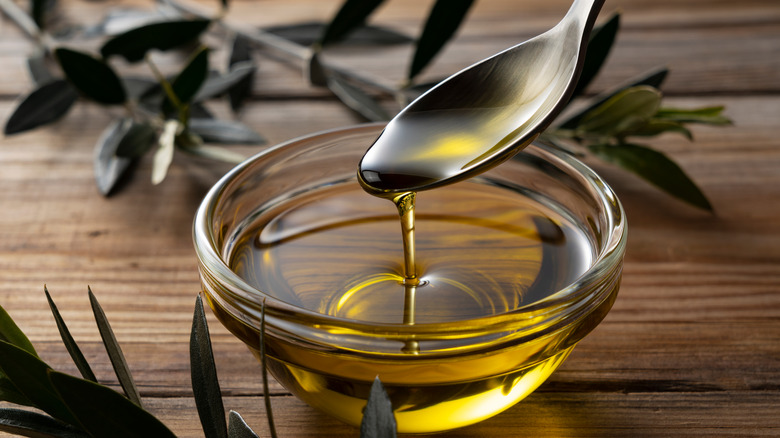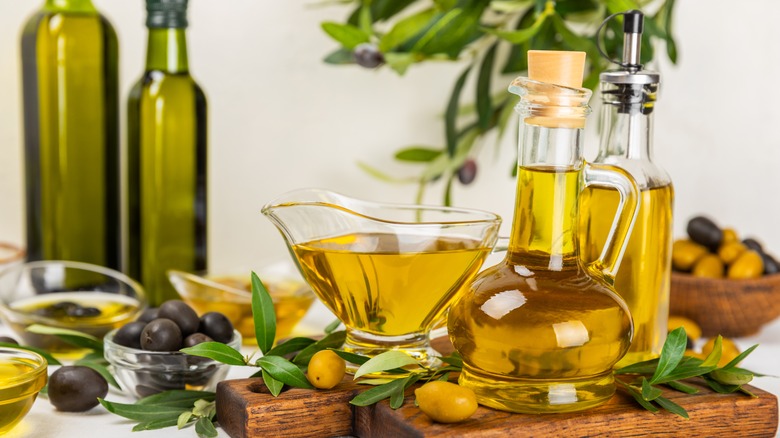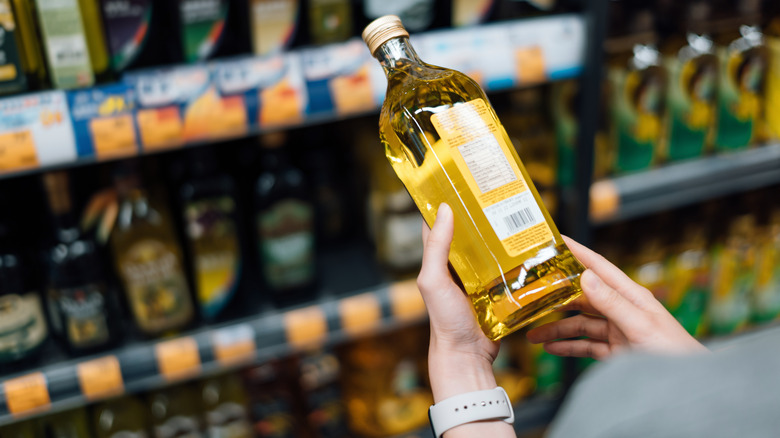Can Olive Oil Ever Really Go Bad?
Costco gets high praise for a variety of items, and consumers claim that its Kirkland Signature Organic Extra Virgin Olive Oil sets a standard that other brands can't match. If you've ever stood there and wondered if olive oil in those large containers will go bad before you can use it all, we have some good news for you. While olive oil does go rancid and will lose both flavor and nutritional benefits, it's not going to make you sick if you accidentally use some in a recipe. It may taste a little funky, but there's a massive footnote to this: You still shouldn't keep using that old olive oil because of the chemical process it has gone through.
What if you opted to follow expert advice and swap those plastic or glass containers for a ceramic or stainless steel container that's going to keep the light out? That means you may have thrown away any containers with best-by dates on it ... so, now what?
Pour a little bit out, swirl, sniff, and give it a taste — secure in knowing that it's not going to make you immediately ill. If the olive oil reminds you of taking a deep breath of a new box of crayons (or tasting old lipstick), it's reached the end of its life. Another telltale sign that olive oil is rancid is how it feels when you taste it. If it feels waxy instead of oily, it's time to get a fresh jug.
Here's the science of why olive oil goes rancid
Taking olive oil's shelf life into account is fine, but it's important to keep in mind that those best-by dates are assigned with the assumption that the olive oil has been stored properly. When exposed to factors like heat and light, it can take just a few months for extra virgin olive oil to start turning rancid. Why does this happen?
Olive oil contains chlorophyll, the microscopic molecules that give plants their green color and produce oxygen. When olive oil is exposed to light, it kick-starts a process called photooxidation. Oxidation — which also happens gradually over time — starts breaking down some of the things that make olive oil so good in the first place, like healthy fats and antioxidants.
When those components break down, they start to form something called free radicals. These compounds have been associated with causing things like cell damage and vitamin depletion, and they've also been linked to conditions like Alzheimer's and diabetes. They can also cause major gastrointestinal distress, so while a quick taste to see if your olive oil is starting to turn isn't going to hurt you, you definitely shouldn't assume that it's going to be infinitely safe to eat. Fortunately, there are a wide variety of uses for olive oil that will help you use up a container well before it starts to turn funky.
Keep this in mind to make sure you always have the freshest olive oil
Different types of olive oil have different shelf lives, and that's due to the amount of processing they undergo before making it into that bottle. Generally speaking, extra virgin olive oils are good between 12 and 18 months, while other, more processed versions of olive oil will last a little longer, and be good for up to two years (when stored properly).
There's another thing to keep in mind here, too, and as we mentioned, time plays a major part in how olive oil ages and ultimately deteriorates. That's why it's important to read olive oil labels properly in order to make sure you're buying the freshest bottle.
That means looking for a harvest date in addition to a best by date. The harvest date is precisely that: It's when the olives were picked from the trees. A good rule of thumb is to buy olive oil that has a harvest date of the previous year. If there's no harvest date, that can mean the bottle might contain olive oil from olives that were harvested over the course of a few months, which isn't necessarily a bad thing. Olive oil without a harvest date isn't a dealbreaker, but if you want the best of the best? The presence of a harvest date — usually found on single estate products — is a sure sign of quality.


